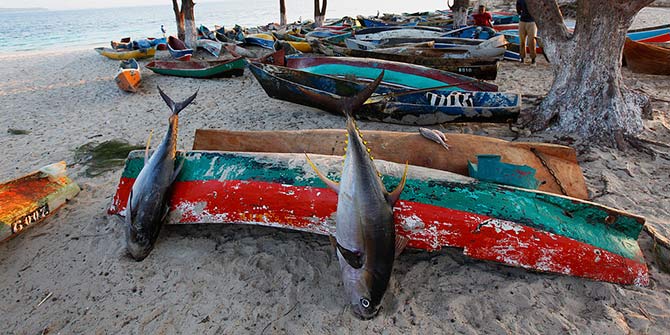Kim Gurney takes readers through Johannesburg via three arts projects. It is a journey that gives a unique insight into the potential of public art to fashion new public imaginaries of common space says LSE’s Kate Dawson.
The debate about public space is not a new one. It is one that resurfaces in many guises, across many disciplines. And yet, in The Art of Public Space: Curating and Re-imagining the Ephemeral City, Kim Gurney manages to resist the tempting allure of locating debates within already established parameters, guiding us instead to new and productive vantage points. Taking us through a series of Johannesburg-based festivals, entitled New Imaginaries, we are presented with an exceptional insight into the potential role of public art in fashioning new public imaginaries of common space.
 Devised by the Goethe-Institut South Africa in 2012, the New Imaginaries project delivered a trilogy of festivals, which sought to respond to what philosopher, political scientist and public intellectual, Achille Mbembe, referred to as a ‘crisis of imagination’ in our thinking about Johannesburg. For many scholars of the South African city – and African cities more broadly – there is a growing consensus that we need to work toward shifting our ways of talking and thinking about the city, from one framed by potential crisis to that of potentiality.
Devised by the Goethe-Institut South Africa in 2012, the New Imaginaries project delivered a trilogy of festivals, which sought to respond to what philosopher, political scientist and public intellectual, Achille Mbembe, referred to as a ‘crisis of imagination’ in our thinking about Johannesburg. For many scholars of the South African city – and African cities more broadly – there is a growing consensus that we need to work toward shifting our ways of talking and thinking about the city, from one framed by potential crisis to that of potentiality.
Writing from the African Centre for Cities (ACC) at the University of Cape Town, Gurney situates New Imaginaries within this drive to shift our knowledge about Johannesburg and African cities from a discussion that situates the city as existing in a constant state of emergency, to seeing the urban as multiple spaces of emergence. For Gurney, in a city where space and power are historically linked, any debate about public space should take seriously the extent to which such power relations have been etched onto Johannesburg’s cityscape. In this way, New Imaginaries makes a critical intervention, inviting us to see anew the spaces ‘in between’ as sources of imagining alternative ways of being in the city, beyond those defined by existing relations of power.
The first of the three festivals, Shoe Shop, sought to celebrate movement and migration. Made up of artist-led city walks, a film festival and photographic art installations in public spaces, Shoe Shop engaged with ideas of mobility in the city and how such movement works to fashion new urban realities. The second festival, A MAZE.Interact, comprised an exhibition, public play and a 48-hour ‘game jam,’ and sought to expose the value of ‘play’ in making things happen. The final festival of the trilogy, Spines, used the city’s transport lines to deliver two performance art interventions, exposing the slippage between the performance artists themselves and the everyday activities of the city. For Gurney, these festivals suggest public art can ‘offer a potential hinge between space and the public sphere to join subjective imaginaries in common’ (page 150) – in essence, to imagine ways of making common space.
The sheer diversity of actors, spaces, histories and futures that are brought into the analysis, speaks to the huge potential that cities offer in fostering endless ways of imagining what the urban is and indeed, what it can be. Indeed, perhaps most captivating in this account is the idea of performativity – that the city is something performed and thus constantly shifting. This allows us to think about the city as something that is constantly made, opening up space to consider how we want that ‘making’ to actually happen. For example, in discussing Shoe Shop, Gurney elaborates the idea of a mapan – a useful way to think about how inhabitants perform the city. A Cameroonian colloquial term, a mapan is a kind of shortcut path made by pedestrians as they move, establishing connections between places and people and effectively making the city in the process. In this way, the ‘doing’ of public art in New Imaginaries is an important tool in exposing how a city’s inhabitants are endowed with the potential to (re)imagine and (re)create common space.

Photo Credit: Spach Los via Flickr (http://bit.l/1UgIDs9) CC BY 2.0
Following this convincing account, Gurney argues we must construct ways of thinking about the benefits of public art beyond the dominant discourse of the ‘creative economy,’ which tends to value public art as means to secure economic growth, jobs and foster social cohesion. In this discourse, the value of the more ephemeral interventions of New Imaginaries are at risk of getting lost. Making an interesting parallel with a principal ecosystems model, Gurney suggests we view public art as a common pool resource and the benefits that flow from it as ‘cultural interest’. This is a thought-provoking way of thinking about the topic and one that could have been usefully developed throughout the book, as opposed to one situated at the end of the account.
Like every city, Johannesburg has its own history, its own contested spaces and its own ways of speaking to the future. The particularities and sheer detail of the ephemeral interventions discussed here is what brings to life this insightful account of public art. Given such specificity, are we able to imagine such interventions in other cities? For me, this book brings something new to the public space discourse that allows us to think beyond the specificity of Johannesburg. It indeed exposes the naturalised ways of thinking and talking about public space, which tend to privilege permanency and definition, while rendering invisible the processes by which public space is actually made. In this way, Gurney re-politicises the debate in new ways, offering us critical tools to re-imagining and re-speak of public space in the city.
IIn the finale of The Art of Public Space, we are taken to the site of ‘Fire Walker’ – a public sculpture located at the foot of Elizabeth Bridge in Johannesburg. Born into the urban montage in 2010, the sculpture, made up of fragmented steel planes, depicts a female trader, carrying a brazier upon her head. By way of design, the sculpture yields multiple images at various vantage points, privileging fragmentation over coherency, ephemerality over monumentality. Such privileges form the backbone of this insightful elaboration of public space and it is to these that we should commit if we are to envisage new public imaginaries of common space that allow us to fashion alternative ways of being in the city. Any debate on public space would do well to take these commitments seriously.
The Art of Public Space: Curating and Re-imagining the Ephemeral City. Gurney, K. (2015) Basingstoke: Palgrave Macmillan
Kate Dawson is a doctoral researcher in LSE’s Department of Geography and Environment. Follow her on Twitter @KateEDaws.
The views expressed in this post are those of the author and in no way reflect those of the Africa at LSE blog or the London School of Economics and Political Science.





